Analyzing Ball Juggling Tricks

Table of Contents
Introduction⌗
I want to understand what makes up a juggling pattern. Particularly I am interested in toss juggling patterns with 3 or 4 balls, as these can be very complex in the way the balls move in relationship through the body and each other, whilst at the same time not having to deal with the complexities of props in which the orientation and spin plays a role.
Some of the aspects that make up tricks are already well described, such as siteswaps, others less so. In this article I will take a bunch of tricks and attempt to describe them, and see what systems are already available for this.
In an attempt to be less biased in which tricks I select to analyze I have selected only tricks from the jugglers in the top 10 of the Top 40 Jugglers 2021, who have released at least one 3 or 4 ball juggling YouTube video in the past year. These jugglers are Taylor Glenn, Zak McAllister, Kouta Oohashi, Wes Peden and Domenyk La Terra. They have all kindly given me permission to use their footage here.
From their most recent ball juggling videos I selected repeating patterns as these were easier to analyze than non repeating sequences. From those tricks I filtered to include as many unique features of tricks as possible but no duplicates, and a final selection was done based on personal interest in order to get to a manageable amount of tricks to analyze and describe.
I have given each trick a name so that it is easier to refer to them.
Whenever possible, the trick was also animated using Juggling Lab in order to get a better understanding of the pattern.
Left and right are described from the jugglers point of view.
Each first occurrence of most juggling terminology in this article links to a page explaining the term, either elsewhere on this blog or on external websites which I deem to have the correct understanding of the term.
Update: I have attempted to also describe these tricks using Rhythmic Catches and IMBO, you can find these transcriptions here.
Tricks⌗
Stacked synch 4b windmill⌗
These video clips from Taylor Glenn originate from this IJA Tricks of the Month.
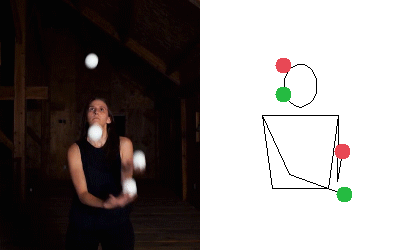
This trick could be described as a synchronous 4 ball version of a windmill.
The siteswap is (4,4), the right hand (green ball) throws the BTN path OPALAC. In IMBO it would perhaps be difficult to decide if this trick follows /M~H~\ or M~/H~\ as one needs to decide whether the hand crosses the M~ (middle opposite) hole whilst it is still holding the ball. I would argue that M~/H~\ is more clear as the hand definitely needs to move in the direction of the hole for the trick, even if the hand does not pass all the way through.
The left hand (red ball) is throwing the balls from outside to inside, the right hand is throwing inside to outside (the default in juggling). There is notation for inside and outside for example in MMSTD.
With only these definitions, the simplest way imaginable to execute the trick would be this:
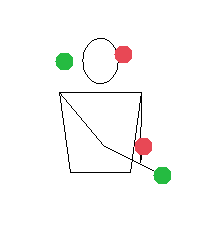
I would suggest that the final features required to get to the original trick can be seen as “stylistic features”, and not as core components of the trick. These stylistic features would be for the 2 balls to always be right above and below each other on a vertical line, and for the pattern to take the width of the shoulders.
Aspects that I consider difficult to notate:
- Stylistic features such as the pattern width
Synch 4b claw multiplex⌗
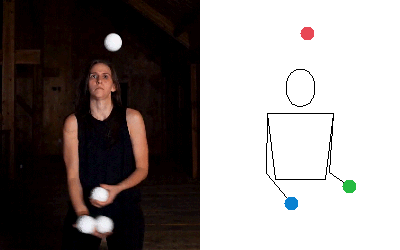
This trick could be described as a 4 ball multiplex version of column crossunders.
The siteswap is ([4x3],4x)(4x,0)!(0,1x)!*. An ! in a siteswap means a “short” beat, the synch event takes only 1 beat rather than 2. A simplified version without ! could be ([4x4x],4x)(4x,0)*. The single throw (red ball) has the path ACAL, the throw and catch position could be clarified with the IMBO /H\M. The multiplex throw (blue balls) has the BTN path OPALAC, which is definitely thrown /M~ but it could be argued that the first catch is made as either \H~ or H~\. I would suggest that using H~\ for both balls could be less confusing, and there needs to extra description to explain that a claw catch is made: The outer multiplexed ball is being caught with a claw catch before the inner is caught next to it with the hand down. There is notation for claw catches in Harmonic Throws.
Finally the green ball is thrown at the same time as the multiplex, and it does something odd: It is being thrown on the inside of the red ball. But because the red ball is not returning to the hand that threw the green ball it can not be described as a typical inside (a normal/default) throw since that would relate to an incoming ball. As far as I know there is no standard juggling language to describe the position of objects relative to other objects like this. It is however possible to describe with a drawing or diagram such as Gillson diagrams. In this particular case we’re perhaps in luck, the jugglers arm is also extending through the IMBO H~ hole so the throw path could be described with H~/\H~. Lastly, this ball is being carried to the top of the pattern and then dropped.
Aspects that I consider difficult to notate:
- Object position relative to other objects
- Carrying
Trace around with foot catch⌗
These video clips from Zak McAllister originate from DR POP.
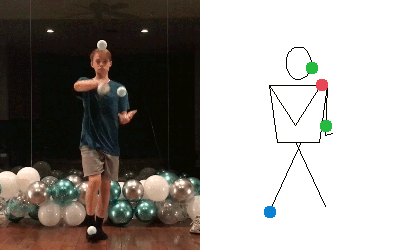
This trick could be described as a variation of a 3 ball slice or tornado, but rather than just going through 2 balls one time, the hand holding the ball traces a path around 3 balls, one of which is thrown and caught by a foot.
The siteswap that I’ve used to simulate this is <(2,[42T])|(0,0)><(2,2T)|(0,4)>. This contains some uncommon notation let me break it down a bit: the <a|b> signifies a multi juggler pattern for jugglers a & b. I have noted the foot down as a second juggler doing (0,0)(0,4). The T means a “throw” for an object that is typically held, like some of the 2s in this pattern. For convention’s sake the hand holding the ball is doing (2)(2), but as no throw is made with it at all it could have just as well been written as (4H)(0) with H for hold, or even as (1x)!(1x)!(1x)!(1x)!.
The feet were animated in Juggling Lab by using the hands of a second juggler hidden behind the first.

The left hand doing the multiplex sequence (green balls) does an uncommon move: The first ball to return is slapped instead of caught. I am not aware of a way to notate this, and it confuses the timings typically associated with siteswap a bit. Most throws return to a hand about 2 beats before they are thrown again (which is why a 2 is typically not even thrown). However, when the ball is slapped this can be seen as being thrown and caught instantaneously, so a 2 that is about to be slapped needs to take 2 beats before it goes back to the hand. Which is the same amount of time that the 4 from the multiplex is expected to arrive. One possible way to solve for this is by turning this from a 4 beat siteswap into a 5 beat siteswap, with the left hand doing ([41xT])!(4)(0)!(1x)!, and with the first 1xT being slapped. I decided it was alright to use the easier 4 beat version as there is often some wiggle room on the arrival time of multiplex collects. For example in the pattern [333]33 one is not expected to always catch the triplex in a squeeze catch, they can land just after each other. In this case, it would still be important to note which ball lands first, which is the 4, the slapped 2T comes second. As far as I am aware there is no system which can notate this.
The right hand that is holding the (red) ball is arguably doing most of the action, but does not get any special notation here now, as it is not doing a juggling pattern itself. Instead, we’ll describe its movements through the holes and thus pathways it creates for the other balls in the patterns. This would also work if the hand were empty.
For example the right foot is only doing a single kick up and catch, but the ball is taking the IMBO path /HMH\M. This can only be done if the hand circles around the ball in mid air.
The lower multiplex ball takes the path M~/H~\. After it is hit it does not perform a path around the body. The upper multiplex ball follows the path M~/H~H~M~\.
The balls in the multiplex exchange positions every round, the ball held in the front becomes the ball held in the back, and vise a versa. In this case I not consider it very important to notate this as a juggler could hardly tell the difference between this and a non exchanging version of the trick, however there are situations where this could be relevant for a trick, for example when juggling differently colored balls.
Aspects that I consider difficult to notate:
- Slapping or hitting objects
- Noting the order in which balls arrive on when they are collected on the same notated count but not as a squeeze catch.
Tape cassette⌗
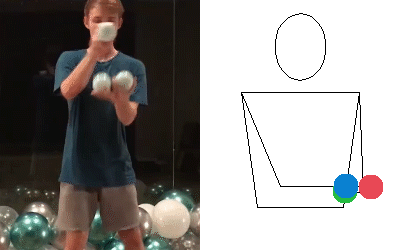
I named this trick “Tape cassette” as its shape reminds me of how tape is wrapped around two spools.
The siteswap of this trick is 2[2T2]2[22T]. Similarly to the previous trick the path of the right hand can be described by the IMBO paths of the thrown balls, which is M~/H~\ for each of them.
Unique in this trick is that the two balls in the left hand (blue and green) are placed side by side in a way that appears to be relevant for the trick. The juggling simulator is unable to show this, and I do not believe there to be any standard juggling language to describe such positions.
Aspects that I consider difficult to notate:
- Position of multiple balls in a hand
Fake mess under leg behind neck⌗
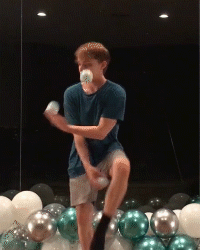
This trick could be described as a variation on the fake mess, with the 3 being thrown behind the neck and the 2 extended under the leg.
There is no animation of the trick as the Juggling Lab can not simulate throws around the neck starting from the front of the body, nor can it do leg raises without getting creative like in the trace around with foot catch simulation.
Most parts of this trick could be accurately defined with the methods we have used so far. The siteswap is 423, the 3 path is IMBO H~/H~H\H. The 2 path does not use any throws and catches, so it does not make a difference whether we note it as IMBO LL or BTN BOLBOL.
What is not described now is whether a leg is being lifted up or not. For some tricks this can be relevant such as when comparing albert throws with normal under the opposite leg throws.
Also, one may argue that it is relevant in which direction the arm is being extended through the legs. BOLBOL or LL could just as well refer to a hand sticking between the legs to the back or to the opposite side. When a ball is being thrown through the legs the direction of the hand could normally be deduced from the direction the ball will have to be thrown.
In this particular case the easiest option was performed for both the arm extension direction and the leg lifting, which is why I don’t consider it to be very important to be written down right now. Also, in my opinion these distinctions are in the grey area between “essential parts of a juggling trick” and “stylistic variations/dance”.
It is possible to make these distinctions with a visual diagram system such as the Benesh part in Harmonic Throws.
Aspects that I consider difficult to notate:
- Leg raised or lowered
- Arm position in a move without a throw or catch
7423 slam⌗
These video clips from Kouta Oohashi originate from YAGAKU.
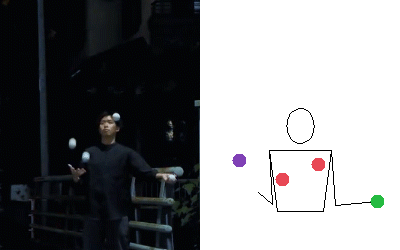
This trick could be described as siteswap 7423 with the 3 (blue) slammed.
There are more throws in the trick, the complete siteswap is 53474234. Let’s discuss the throws one by one:
5(red from right hand) is thrown normal3(green from left hand) is thrown outside4(blue going straight up) is thrown outside, slightly higher than usual in preparation for the slam7(purple) is thrown normal4(green from right hand) is carried and dropped2(red in left hand) is held normal3(blue going across) is first caught at the top of the pattern, then slammed over the green ball4(red from left hand) is thrown normal
If we were to write the siteswap again, but adding o for outside, s for slam and c for carry, it could be shortened to this: 53o4o74c23s4
I am not aware of any notation that deals with slams. They are a form of outside throw, but are different from normal outside throws in that the ball does not move upwards in the air, and thus the throwing hand must be raised above the incoming ball at the moment of the release.
It is not possible to describe this position with the IMBO definition of overheads as the hand does not get inverted and thus the ball stays in the topological front of the body.
Aspects that I consider difficult to notate:
- Slams
4b elbow trap⌗
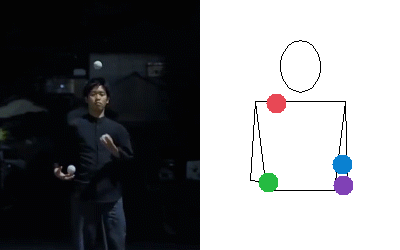
This pattern could be seen as siteswap 552 were the the second 5 is a low throw into an elbow trap and the 2 as a drop from the elbow into the hand.
To be more specific about the timing and different catch positions it could possibly be written as dNote {L,R,El,Er} (3,0,0,1x)(2,1E,1-x)*, with E meaning elbow. It was animated in Juggling Lab with siteswap <(3,0)!|(0,1x)!><(2,1p)!|(0,1xp)!>*, the second juggler has been made invisible.
In the Points Stratégiques du Corps Jonglé the inside elbow position is called Eli. However, in this particular case the ball is not only in the caught in the elbow, but also resting against the body. When an object is pinced by two body parts at once I call this trapping. As far as I am aware no notation system deals with trapped objects.
Aspects that I consider difficult to notate:
- Traps
Over under cascade⌗
These video clips from Wes Peden originate from LEMONS.

This trick could be described as Mike’s mess with the left hand throw going under both arms instead of over them.
It is not possible to adjust the elbow positions in Juggling Lab which is why the simulation is not completely accurate.
The siteswap is 33 with the 3 from the left hand (blue) taking the path M~/M~M\M and the 3 from the right hand (red) taking the path M~/H~H\M
Aspects that I consider difficult to notate:
None! That’s a first in this article. But I still wanted to include this as I could possibly use it later as a reference when discussing the animation of elbow positions.
522 through⌗

This trick could be described as 522 with the first 2 being used to carry the ball to the top and opposite side of the pattern, and the second 2 as some kind of slam.
Alternatively it could also be seen as siteswap (4x,2)* which may fit the rhythm of the pattern better, but it means there is a lot of action going on one 2.
It’s not a typical slam as the ball does not go over the next incoming ball, the next incoming ball is the 2 itself. It is going around the 5 from the inside to the outside, as seen from the perspective from the hand performing the 2. This is a similar problem as we had in the synch 4b claw multiplex: there is no simple way to note the object position relative to other objects when those are not the incoming object. In this particular case it might also be useful to describe the path that it takes around the ball, with the carry and the “slam” together it does a full circle around the 5, with the left hand 2s making a clockwise circle and the right hand 2s making a counter-clockwise circle (from the jugglers point of view).
The 5 is caught as a penguin catch, making it /H~\Mp
Aspects that I consider difficult to notate:
- Object pathways relative to other objects
423 carry around head⌗

This pattern has siteswap 33423. The first 3 is being thrown up straight and higher as if it were a 4, because the hand for the second 3 wants to receive it after a carry to the opposite side. This second 3 is dropped from the top into the pattern. A normal 4 is thrown and then the 2 is carried around the head, H~H.
The final 3 is where it gets interesting for us, this is thrown kinda like H~/H~\, but if I were to read that I would assume a stretched arm rather than a bent arm. Because the arm is bend it feels as if the ball goes over 2 body parts, the upper arm and lower arm. Is that worth notating, or is that a minor stylistic variation? Questions, questions…
Aspects that I consider difficult to notate:
- Folding the arm or keeping it straight when creating holes for a body trick
Pirouette hold behind neck⌗
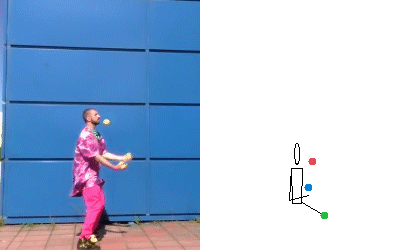
It is surprising to me that there is no notation for pirouette except in dance notations such as Laban and Benesh, but even the simplified Benesh version for Harmonic Throws makes no mention of it.
In siteswaps often 22 is noted to indicate a pirouette, which is why I’d say this trick is the siteswap 336222. However, as with any trick with long holds it could be interpreted in different ways, for example as 3342. If we want all beats spaced equally I’d say the high throw is more like a 5x, but putting that in a siteswap makes it much more complex, unless we are to use dNote.
The first two 2s in 336222 are being carried behind the head, the left hand doing H~H and the right hand HH~.
Aspects that I consider difficult to notate:
- Pirouettes
Elbow zip in out⌗
These video clips from Domenyk la Terra originate from the IJA Tricks of the Month.
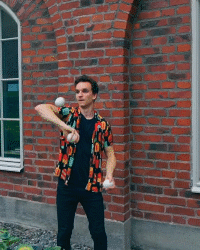
This trick is not animated as there is no control over the elbow positions in Juggling Lab.
It could be seen as a siteswap 423 with the 4 being hit twice by the opposite elbow, and the 2 arm performing those hits.
Alternatively, one could try to turn this into multi manipulator siteswap using dNote. In that case there are 6 manipulators: Hands, elbows inside, elbows outside, all left and right. However, even then there is no clear way to note it down, as a slap with the elbow inside is made right after a 1, which means that the slap and the zip happen on the same beat. Writing that on the same beat would suggest that the ball exists in two places at the same time, which might be half true but would be very confusing to read.
Points Stratégiques du Corps Jonglé suggests the name Eli for the inside of the elbow, and Els for the side of the elbow, but it is unclear which side of the elbow is intended. In some cases the Eli seems to point to the top of the elbow where a gripping catch can be made, but in this case we could use it to point to the inside side of the elbow, and Els for the outside side.
Aspects that I consider difficult to notate:
- Hits after a
1
Stack slap sequence⌗
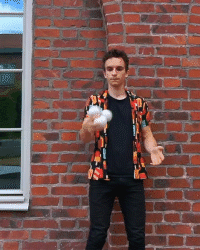
A lot of small movements happen in this trick, making it hard to pinpoint the siteswap.
It’s becoming clear that patterns this complex might also be too difficult to note down in dNote in a useful way. My attempt is this: {L,R,Kl,Kr}([42T],0,0,0)(1,1x)(3HK,[22])0(1,[22])(1x,1)([222T],1-)(1x)([1322])(2x)*, which adds a T for a thrown 2, H for a hit except when the hit takes place on a 1, and K for knee. But I can’t guarantee that this notation is correct, it was too complex to test completely.
This is the dNote transcribed to siteswap for Juggling Lab: <([42T],0)!|(0,0)!><(1,1x)!|(0,0)!><(3xp,[22])|(0,0)><(1,[22])!|(0,0)!><(0,1x)!|(1,0)!><(0,[222T])!|(0,1xp)!><(0,1x)!|(0,0)!><(0,[1322])!|(0,0)!><(2x,0)!|(0,0)!>*
In large part this notation becomes obfuscated because there is so much notation for balls that are being held or balls that are not there. If it were possible to only note down the balls when action is taken on them, a notation could look more like this: ([42])(1)(3HK)(1)(1)(2,1-)([13])(2x)* which looks much less overwhelming.
There are two new things in this trick that we have not seen before: A small variation on the slap is a slap in which there are already balls in the hand, making it some kind of multiplex with held balls. More interestingly, a ball is slapped with the backhand. This is one of the 10 hand positions described by Le Corps Jonglé, they call it G. Similarly it has been described by Points Stratégiques du Corps Jonglé where it is called Hb for “hand back”. This system marks only 7 hand positions, 5 of which are individual fingers. There is no common way to notate these hand positions.
Aspects that I consider difficult to notate:
- Balls and beats that are doing nothing
- Positions of interaction on the hand
Conclusion⌗
I am very happy that within the most recent videos of these 5 jugglers I was able to find examples of all trick features that I want to consider. There are of course more possible aspects of a trick that do not appear here, and perhaps those will be discussed later, but at least we have a good list to start with.
Aspects of tricks that I consider difficult to notate, compiled from all the tricks above and reordered to have similar ones close to each other:
- Object position relative to other objects
- Object pathways relative to other objects
- Carrying
- Slams
- Traps
- Slapping or hitting objects
- Hits after a
1 - Noting the order in which balls arrive on when they are collected on the same notated count but not as a squeeze catch.
- Position of multiple balls in a hand
- Leg raised or lowered
- Arm position in a move without a throw or catch
- Folding the arm or keeping it straight when creating holes for a body trick
- Balls and beats that are doing nothing
- Positions of interaction on the hand
- Pirouettes
- Stylistic features such as the pattern width.
Not all of these features should perhaps be considered of equal importance for the design of a juggling notation system, but they will likely all be considered.
I am looking forward to a future in which all these tricks above can be described with notation, and generated from rules.
Are there important features of juggling patterns not discussed here? Wanna share your thoughts of how these tricks could be described? Don’t hesitate to contact me.